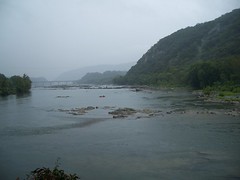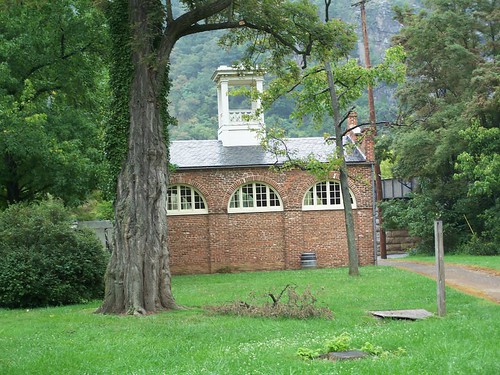 We started off our field experiences with a trip to Harpers Ferry National Historical Park. We were all up early in the morning, bright eyed and bushy tailed as the expression goes, and although it looked like rain we started off in high spirits. At the visitor center we met Dennis Frye who would be leading us on the battlefield, and other battlefields to come. Harpers Ferry is an amazing place because it is known for more than one famous occurrence. The two that come to mind are the 1859 raid by John Brown and the September 1862 Civil War battle.
We started off our field experiences with a trip to Harpers Ferry National Historical Park. We were all up early in the morning, bright eyed and bushy tailed as the expression goes, and although it looked like rain we started off in high spirits. At the visitor center we met Dennis Frye who would be leading us on the battlefield, and other battlefields to come. Harpers Ferry is an amazing place because it is known for more than one famous occurrence. The two that come to mind are the 1859 raid by John Brown and the September 1862 Civil War battle.We began with the battlefield since the change of rain was worse for the afternoon. Dennis took us first to Bolivar Heights to get a perspective of the battlefield. Harpers Ferry is at the junction of the Shenandoah and Potomac Rivers and is a triangle of "high-ground" made of Bolivar Heights, Maryland Heights, and Loudoun Heights. In the present day it is also the junction of three states: Maryland, Virginia, and West Virginia. Dennis took us to both the Union and Confederate lines and the locations of the major movements during the battle. Harpers Ferry is a well preserved battlefield and we were able to get a really good feel for the movement of the battle in 1862. We walked the confederate lines on Schoolhouse ridge and, even though we have a lot of work to do before we can march in a respectable line formation, it was easy to see the courage of the soldiers that fought on both sides of the conflict.
 Even though it had been raining all day and was getting heavier we went back out on the field after lunch. This time we went out to the Old Town where John Brown's Raid had occurred in 1859.
Even though it had been raining all day and was getting heavier we went back out on the field after lunch. This time we went out to the Old Town where John Brown's Raid had occurred in 1859.Unfortunately for the town, the Civil War had caused so much damage that it never fully recovered and 60% of the original town is no longer there. Dennis brought us to the site of the armory buildings that John Brown and his men had attacked to get arms to fight Brown's own war against slavery. The only original building significant to the raid that still stands is the engine house where the final assault by the US Marines occurred and John Brown was captured. Sitting inside the tiny building Dennis took us through the events of the raid and the dramatic conclusion that reverberated throughout the states and impacted opinions on slavery just two years before the Civil War would begin.
Wet and tired but full of new knowledge we headed home to the Appleford. Next week Manassas!!!
-Katie Logothetis

No comments:
Post a Comment